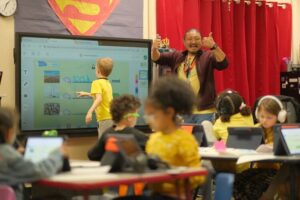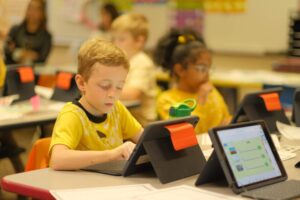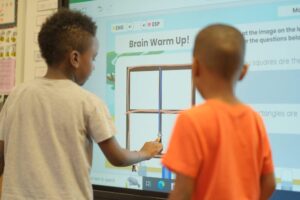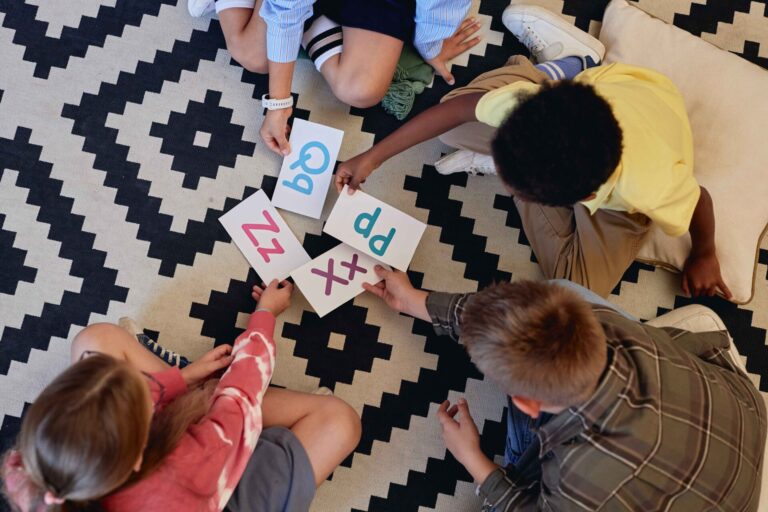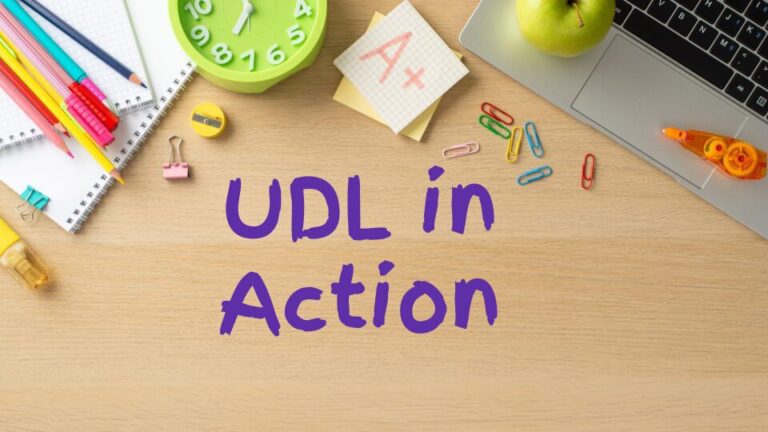In the vibrant classrooms of Oklahoma, educators are shaping the minds of their students and utilizing Seesaw to enhance their teaching practices, foster student engagement, and connect with families in meaningful ways. Seesaw, an interactive digital platform, has become a game-changer for Oklahoma educators, giving them the means to better engage students, assess their progress, and forge stronger connections with them and their families.
MS. EDWARDS – KINDERGARTEN TEACHER
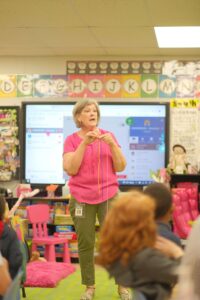 Through her use of Seesaw, Ms. Edwards has created a classroom environment that is both engaging and effective for her students. By providing a balance of hands-on and digital learning experiences, she is able to ensure that every student is learning at their highest potential.
Through her use of Seesaw, Ms. Edwards has created a classroom environment that is both engaging and effective for her students. By providing a balance of hands-on and digital learning experiences, she is able to ensure that every student is learning at their highest potential.
“I absolutely love Seesaw,” Ms. Edwards says. With the platform, she assigns a variety of activities to her students and sees their responses in real time. “This helps me quickly assess who needs more support and adjust my lessons accordingly.”
When we visited Ms. Edwards’ class, her students were learning about measurement. She used a combination of hands-on manipulatives and a Seesaw activity in which students compared the length of objects and put them in order.
Some students practiced measurement with the lengths of yarn, while others independently completed the Seesaw activity where they sorted the objects by length. As the responses from the Seesaw activity rolled in, Ms. Edwards carefully reviewed each response. With this information, she identified which students understand the concept and which students need more support.
“I absolutely love Seesaw.. [it] helps me quickly assess who needs more support and adjust my lessons accordingly.”
Ms. Edwards continued to circulate the classroom, praising students for their work, probing deeper into student understanding, and addressing questions that arise. Seesaw was seamlessly integrated into her classroom routines. Students intuitively picked up their devices and got to work on the activity, moving objects and annotating the digital canvas to demonstrate their knowledge of measurement and size.
The students clearly knew how to complete each activity and Ms. Edwards took full advantage of the real-time insights.
MS. BAKER – 1ST GRADE TEACHER
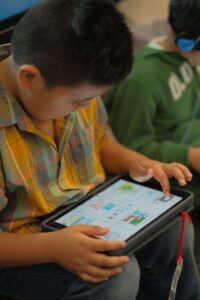
One of the most popular learning stations in Ms. Baker’s classroom is Seesaw. She says, “I only showed them once or twice, but the students knew how to get started.” At this station, students worked independently on activities that reinforce the learning goals.
As soon as the students put on their headphones and log in, they’re completely immersed in learning. “Students love to work with technology,” Ms. Baker says. “So I use this motivation to capture learning and track their progress.”
Ms. Baker uses stations daily in her classroom. She began her stations by grouping students around the room. One group grabbed a book for independent reading, some migrated to the kidney table for guided instruction, and the rest logged on to iPads for the Seesaw station. Today’s lesson focused on reading consonant-vowel-consonant words. Ms. Baker preassigned a Seesaw activity for the students to complete.
The activity prompted students to fill in the missing letters to complete vocabulary words. This Seesaw activity had learning supports such as audio recordings that pronounced the word and visuals of what each word is. Students choose their favorite color pen and use the built-in supports to answer each question. Ms. Baker was confident in her students’ ability to complete the Seesaw station independently, allowing her to provide guided instruction to a group of students at the kidney table. Upon completing the Seesaw activity, the students placed their iPads back into the card and hung their headphones on the handle in preparation for switching to a new station.
By incorporating digital tools like Seesaw into organized classroom routines, Ms. Baker has created an environment that encourages independent learning and fosters student engagement while providing immediate feedback to help steer instruction.
“Students love to work with technology, so I use this motivation to capture learning and track their progress.”
— Ms. Baker
MR. SCOLES – 1ST GRADE TEACHER
As soon as you step into Mr. Scoles’ classroom, you can feel the excitement of learning in the air. The lesson kicked off with a student-friendly video, laying the foundation for important background knowledge, which seamlessly transitioned to the first Seesaw activity.
Mr. Scoles projected an activity to the class where they used the move and drawing tools to sort vocabulary words by the sound-spelling pattern. Upon opening the lesson on the board, students’ hands shot up eagerly, each hoping to be selected to fill in the answer on the board. “My job is to motivate students to learn, and Seesaw does this for me,” he explained.
Following the Seesaw letter blending activity, Mr. Scoles reinforced letter sound spelling by asking students to listen for the sound within words. He continued to call students up to the board to share their answers. After listening to word pronunciations on Seesaw and identifying the correct sound, students wrote their answers using the drawing tools. As one student completed their work on the board, the rest of the class followed along and responded on their own devices.
After identifying the sounds within words, the rigor of the lesson increased. Students were now challenged to write a sentence after listening to an audio clip. The first student confidently walked up to the board and pressed the audio recording button. After listening, this student began to write the sentences. Midway through writing, it was clear the student forgot the rest of the audio clip. Mr. Scoles noticed this and prompted the student to listen again. After listening to the clip a second time, the student completed the sentence. After writing the full sentence, Mr. Scoles erased the answer key and the classroom checked their answer, which of course was correct. The classroom celebrated by reading the sentence aloud and thanking the student for their hard work.
The combination of Mr. Scoles’ effective teaching strategies and the intuitive design of Seesaw creates a dynamic learning environment where students thrive. With Seesaw as a trusted companion, he confidently guided his students through engaging activities and lessons, ensuring that every child remained fully immersed in the learning process.
“My job is to motivate students to learn, and Seesaw does this for me”
— Mr. Scoles
MS. HOLLOWAY – K/1 TEACHER
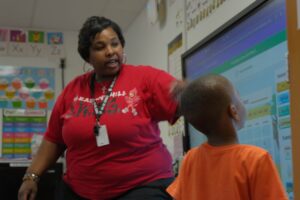
During our visit, Ms. Holloway taught a lesson on calendar math, where students completed the brain warm-up before their math block. A student leader guided the class through the lesson by reading warm-up questions aloud, “How many squares can you see?”
A buzz filled the classroom as students discussed their answers. After purposeful thinking time, the student leader called upon classmates to share their answers. Multiple answers were shared and Ms. Holloway used this as an opportunity to reinforce how everyone thinks differently. A calm resonated throughout the room as each student turned to a neighbor and repeated “I like the way you think.”
After more conversation about the number of squares, the classroom reached a consensus. The classroom leader then used the drawing tools to outline each square on the page. After finishing the drawing, the classroom leader read the second question, “How many rectangles do you see?” This prompt was much more difficult for the class. They continued to share answers and details about how many squares were present. Ms. Holloway, being a veteran teacher, used this as a teaching moment to refresh her students’ understanding of what a rectangle was in comparison to a square.
After a few audible “Oh, now I get it” responses, the class was ready to answer. The student leader called on a friend to help outline the four rectangles they found. The final piece of this lesson was to record their answers using their voice. The student leader knew exactly which tool to choose, quickly moving to the microphone tool and starting the recording. After reading each question and answer to the board, the lesson was complete. Ms. Holloway clicked the green check and thanked the class for their hard work.
It was clear from the student excitement and rich conversations that this lesson was a hit with her class. Students learned from one another’s unique perspectives and approaches, building collective knowledge and providing space to express mathematical thinking. “Students get to learn how their friends think and problem solve,” she said.
MR. KELLERT – BUILDING PRINCIPAL
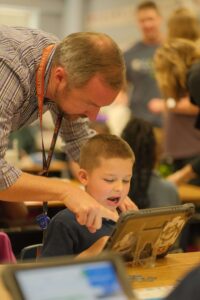
One of the key advantages of Seesaw, as Principal Kellert explained, is its ability to facilitate small group work while keeping all students engaged. “As a teacher, when you want to work with a small group or 1-1, you have to keep the entire class engaged. With Seesaw, our teachers have a great platform to do this. Teachers can assign interactive activities for students to complete while giving personal attention to others in the classroom,” Principal Kellert said. On top of ready-to-teach content, he also highlighted the enthusiasm that students have, adding, “Kids love working on Seesaw… it brings them into 21st-century learning.”
Principal Kellert also emphasized the importance of balance between on and off-screen learning. “We want to make sure that students are engaged in meaningful learning activities, whether they’re on the computer or working with hands-on materials. It’s important to find that balance.”
But Seesaw doesn’t just engage students; it also involves parents in the learning process. “We value family involvement at our school,” Principal Kellert said.
With student portfolios and family communication tools, Mr. Kellert has seen a boost in family engagement and student motivation. “We use Seesaw as a tool to show parents what we are doing. Parents are getting to see, in real time, what their child is learning in class,” he said. Nichols Hills knows the importance of family involvement and the impact that this has on student performance. “It’s important for parents to be engaged in their child’s education and to be aware of what’s going on in the classroom, “ he said.
Nichols Hills is a better school with Seesaw. Teachers have more engaging lessons for students and families are part of the learning process. Mr. Kellert knows how impactful Seesaw has been and uses it to continue moving his building toward excellence.
“We use Seesaw as a tool to show parents what we are doing. Parents are getting to see, in real time, what their child is learning in class”
